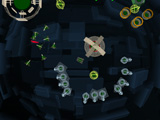Motor Skill Learning in User Interfaces via Discretized Pie Menus
Gamedev.net published my article on discretized pie menus. If you're interested in some of the theory behind the user interface in Gate 88, check it out.
-j
Gamedev.net published my article on discretized pie menus. If you're interested in some of the theory behind the user interface in Gate 88, check it out.
I've uploaded a collection/album of songs I wrote several years ago (dated Jan6/2002) using only Fasttracker2 and Maz's no.1 instruments sample cd. The idea was to severely limit my tools in order to require and encourage creativity. If you liked "Somewhere East" from Gate 88's soundtrack, this should be right up your alley.
Technologies: ideas and sciences enabling humanity to defeat nature and act impossibly. The human is born with two legs and learns to walk, but when he sees a bird in flight he says, "I must fly too," and he takes to the skies. Somewhere in flight, the human discovers the atom, but then he says, "no! 1 = 2" and the atom splits. Years later, the human gives birth to twins, but then he says "it is not by chance," and he clones the sheep.
Like most RTS games, the goal in Gate 88 is to manipulate your army into a favourable position, but unlike most RTS games, there is a serious penalty which increases as the distance from you to the point of action increases (eg. building a factory in deep space requires you to spend a significant amount of time away from your own base). Jack, who's provided some excellent g88 testing/bug-tracking work, has found Liquid War which completely encapsulates this concept into one neat little package.
Possibly the most frustrating games (video or not) are those whose core gameplay mechanic depends on randomization. From the roll of the dice in Monopoly to the lucky headshots in Counter Strike, these games provide the possibility for a player to defeat another player of much greater skill. Often, this initially leads from angry, blood-boiling cries of “OMG NOOB! YOU'RE SO LUCKY!” to questions like “why does this skill-based game allow random noobs to dominate a veteran player? Isn't it a bit of an oxymoron for skill games to have luck?”
As of late, this curious little flash game has been satisfying my late night cravings for gaming goodness. For a game largely dependent on luck, I couldn't understand how it has managed to become so addictive. Is it the cute expressions of the anime characters? Is it the upbeat music coupled with the cruel nature of the goal? Is it because the game requires next to zero attention?

A temporary fix for the Gate 88 choppyness problem is available at the temporary fix page.
So as we've all found out, Gate 88 still can't quite handle eight player network games... but at least the server doesn't bomb out.